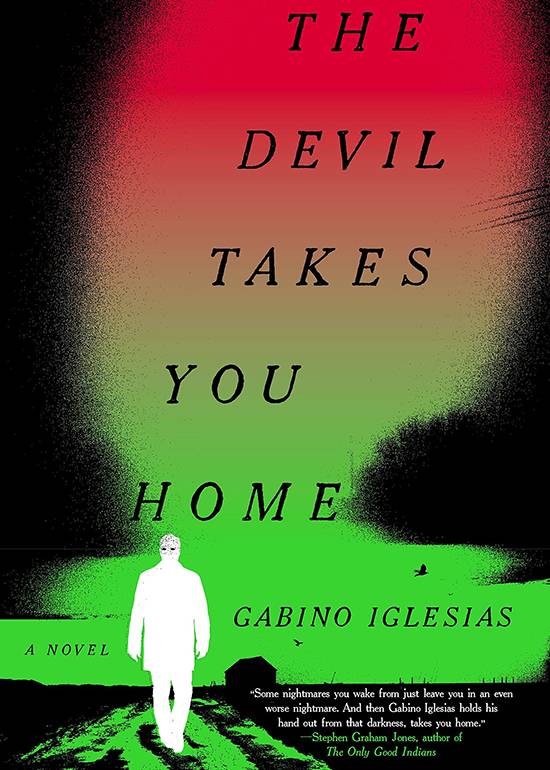When You Stare Into The Abyss

The Devil Takes You Home
by Gabino Iglesias
NY: Mulholland Books, 2022.
320 pp. $28 hardcover.
Reviewed by
William Jensen
If you think you know what happens in The Devil Takes You Home, you’re wrong. Gabino Iglesias has created a novel so violent, dark, and strange that it is hard to compare it to other books. Though there are echoes of classic noirs by James M. Cain and Jim Thompson, Iglesias has penned an original descent into nihilism all his own. It may also be the meanest book I’ve ever read.
The opening chapter sets up a familiar premise. A father decides (perhaps not so reluctantly) to perform a criminal activity to earn the money to pay for his sick daughter’s medical bills. Then things go rogue. And bloody. And weird. Set in Texas and in Northern Mexico, Iglesias confronts issues of race, the borderlands, and drug trafficking through the guise of crime and horror. Though not the first to switch out Chandler’s beloved Los Angeles for the Lone Star State, Iglesias brings a freshness and a spice to Texas crime writing. He uses long passages of Spanish that grounds the reader into character and place. He captures not just the bravado and swagger associated with the region, but he zeros in on the urban sprawl and gentrification in Austin and San Antonio. He drags the genre across gravel and concrete into the twenty-first century.
The protagonist, Mario, narrates the wild odyssey. At times his voice is poetic, riffing off stinging similes on every pages. Lines such as, “the kid’s bones looked like they were trying to escape the thin prison of his skin” and “Her voice broke like a glass thrown against the floor, fast and sharp” ripple throughout.
A gentler writer would try to make the narrator and protagonist closer to an everyman, a guide for the reader to latch onto through the long road into malevolence and the vile. Iglesias chooses a slightly different route. Though his situation should create compassion for the reader, Mario is not always sympathetic. He is capable of cold brutality, and though he stands off to the side for most of the more gruesome scenes, his reflections on the violence can come across as apathetic. Multiple times, Mario addresses the absence of meaning: “The majority of people always want to think life is worth living, that we must do everything in our power to keep going, to stay alive. They don’t grasp that the value of their life is much lower than they imagine.” Later on, Mario thinks: “The thing about humanity is that it’s always worse than the worst you can imagine. We are base, vile creatures rutting in the muck we’ve created, our eyes looking up at a poisoned sky we’ve populated with ghosts to help us sleep at night, to allow us to come up with reasons to do the things we do.” This bleakness will turn off some readers. But I think this is Iglesias’s intention. The book is less about corruption and surviving violence as much as it confronts an inherent nastiness of the human condition. One might compare the book’s bleakness to that other blood drenched Texas novel, Blood Meridian. Indeed, both books include elements of horror and perhaps even magical realism that equally distance both books from their crime and western genres’ tropes. This is an obvious strength for the author. By mixing his genres, he reinvigorates them. I do not feel like giving away spoilers, but there are elements equally George Romero as they are James Ellroy.
As Mario digs deeper into the pit of crime, he meets grotesque characters including meth-heads, drug dealers, rednecks, and even an alligator. I am sure someday a scholar will associate these with various symbols of hell or sinful, demonic archetypes. Every person brings on other layers and complications, even if they appear for only a chapter. Some bits are picaresque but always memorable. There is one scene, already infamous, that involves a bolt cutter. The violence is not what is so disturbing here as much as the context around those involved. It gets dark. Real dark. Luckily, this scene happens early on, so you know after that if you want to keep reading or not. I think you will. Though The Devil Takes You Home lives up to its name, it is also incredibly fast paced. You’ll never get bored. You just might need to watch a few Disney films afterwards for balance. I think the book is bound to be a type of neo-noir classic built on the bones of The Hunter and The Killer Inside Me.
William Jensen is the editor of Texas Books in Review and Southwestern American Literature. His novel, Cities of Men, was shortlisted for the Philip H. McMath award. Most recently, he edited the anthology Road Kill: Texas Horror by Texas Writers, vol. 7.
